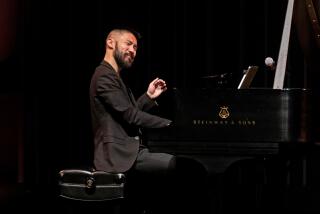Unearthing Prime Piatigorsky of the ‘50s
- Share via
While one didn’t necessary love Jascha Heifetz, who with cellist Gregor Piatigorsky formed the putative modern untouchables of string playing, there could be no denying Heifetz his sovereign technique, even in his last years before the public.
What one heard from Piatigorsky during his last decade or so (he died in 1976) was a good deal of harsh noise and a seeming obliviousness to the niceties of intonation--which one might even call an indifference to the notes.
Some of Piatigorsky’s 1960s recordings, with pianist Artur Rubinstein and with his colleagues in the Heifetz-Piatigorsky concerts, did none of the artists involved credit and may well have confounded younger listeners who considered them representative.
RCA is making amends, so to speak, by digging into its seemingly bottomless vaults for some prime Piatigorsky.
The 1953 recording of Richard Strauss’ “Don Quixote” is as poetic and dramatic an account of that score as the medium has produced, from the cellist and from Charles Munch and the Boston Symphony, with violist Joseph de Pasquale an ideally supportive Sancho Panza (RCA Victor Gold Seal 61485, monophonic, mid-price).
Piatigorsky reflects the Don of Cervantes’ and Strauss’ imaginings as a benign giant. But while his playing here may be grand in gesture and sound, it also discloses utmost sensitivity to rhythm and dynamics.
The coupling is another treasure. Piatigorsky teams with violinist Nathan Milstein, conductor Fritz Reiner and the Robin Hood Dell Orchestra--Columbia’s Philadelphia Orchestra moonlighting for a rival label--for a Brahms Double Concerto of splendid vitality and polish, with no conflict between the cellist’s naturally grand style and Milstein’s patrician elegance. Piatigorsky is immaculate in both roles assigned by the composer: violinist’s companion and center-stage virtuoso.
William Walton wrote his Cello Concerto in 1956 specifically for Piatigorsky, with the deepest appreciation for the particular qualities of his playing.
RCA has recognized the importance of the now-popular work’s first performance by reissuing the 1957 collaboration of the artists involved in the premiere: Piatigorsky, Munch and the BSO.
This is more the bullish Piatigorsky of his last days, with technique somewhat diminished and more frequent resorting to portamento than in earlier days, of the kind that suggests the laborious working up to a note rather than an expressive ornament.
The Walton Concerto’s disc mate is a rather too rough-hewn Dvorak Concerto from the same artists.
RCA’s recording (61498, mid-price) is among the first CD reissues from its line of “Living Stereo” productions, over which audiophiles went gaga a few decades back and which subsequently became collectors’ items.
The contemporary cellist whose sound and style most resemble Piatigorsky’s is Lynn Harrell.
Striking evidence is presented in Harrell’s recent recording of the Walton Concerto (EMI 754572), ideally seconded by Simon Rattle and his City of Birmingham Symphony: as ecstatically voluptuous a reading of this gorgeous score as one is ever likely to encounter.
Harrell, too, projects an immense, throbbing tone, while employing rubato for expressive purposes, not just window dressing.
Furthermore, Harrell and Rattle, unlike Piatigorsky and Munch, have the advantage of playing a work with a history, in which they--unlike the progenitors--have been able to uncover countless subtleties.
The coupling, Walton’s First Symphony, communicated with tremendous power and point by Rattle and his Birmingham players, makes this generously-filled CD one of the most important and desirable recorded releases of the year to date.
More to Read
The biggest entertainment stories
Get our big stories about Hollywood, film, television, music, arts, culture and more right in your inbox as soon as they publish.
You may occasionally receive promotional content from the Los Angeles Times.










